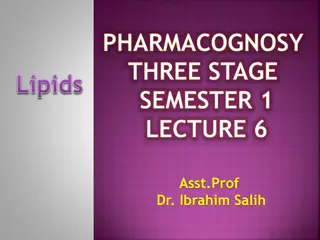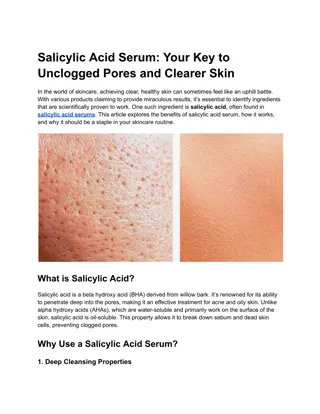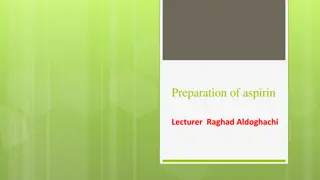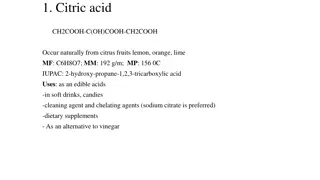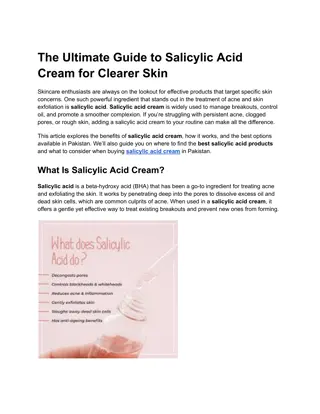The Biosynthesis and Role of Salicylic Acid in Plants
Salicylic acid (SA), a phenolic derivative widely present in plants, plays a crucial role as a regulator in various physiological and biochemical processes. Originally isolated from willow trees, SA is synthesized through the shikimate pathway via metabolic routes involving enzymes like PAL and BA2H. It is crucial for plant defense, signaling, and response to stress. SA can be conjugated in plants through methylation, hydroxylation, and glucosylation, and is also produced via the isochorismate pathway in chloroplasts. Understanding its biosynthesis and role sheds light on its significance in plant biology.
Download Presentation

Please find below an Image/Link to download the presentation.
The content on the website is provided AS IS for your information and personal use only. It may not be sold, licensed, or shared on other websites without obtaining consent from the author. Download presentation by click this link. If you encounter any issues during the download, it is possible that the publisher has removed the file from their server.
E N D
Presentation Transcript
Salicylic acid (SA) (from Latin Salix, willow tree), also known as ortho-hydroxybenzoic acid, is a phenolic derivative widely distributed in the plant kingdom and is known as a regulator of several physiological and biochemical processes such as thermogenesis, plant signaling or plant defense, and response to biotic and abiotic stress Salicin, one of the natural SA derivatives, was first isolated from the bark of the willow tree (Salix sp.) by Johan B chner in 1828 Successively, it was discovered that almost all the willow trees including Salix alba S. purpurea, S. fragilis, and S. daphnoides were particularly rich in this natural compound, in which the concentration in plants significantly fluctuates during the different seasons (highest content during spring and summer, lowest content during autumn and winter values of 3 mg/g of fresh biomass in plants of S. laponum . The first scientist who was able to identify this natural compound in species different from Salix sp. was the Italian chemist Raffaele Piria in the late 1838, who obtained SA in both flower and buds of the European species Spiraea ulmaria successively renamed as Filipendula ulmaria (L.) Maxim. The discovery that this molecule was not exclusive to the Salix genus has opened the door to the study of its biosynthesis, as well as its biochemical and physiological role in plants and in 1899 the Bayer Company formulated a new drug known today as aspirin reaching
From a chemical point of view, SA belongs to a large group of plant phenolics, and SA can be isolated in plants in conjugated form. In particular, the conjugated form proceeds from the methylation, hydroxylation, and/or glucosylation of the aromatic ring both free and
BIOSYNTHESIS OF SA, It is known to be produced through the shikimate pathway by two metabolic routes In the first discovered route, also known as phenylalanine route, occuring in the cytoplasm of the cell, the enzyme phenylalanine ammonia lyase (PAL) converts phenylalanine (Phe) to trans-cinnamic acid (t-CA), which gets oxidized to benzoic acid (BA). Subsequently, the enzyme benzoic-acid-2-hydroxylase (BA2H) catalyzes the hydroxylation of BA aromatic ring and leads to SA formation. The enzymatic conversion of BA into SA by BA2H requires the presence of hydrogen peroxide (H2O2)
The second route is called isochorismate (IC) pathway and occurs in the chloroplast In plants, chorismate is transformed to isochorismate and then to SA, a reaction which is catalyzed by two enzymes isochorismate synthase (ICS) and isochorismate pyruvate lyase (IPL). Recent studies carried on Arabidopsis thaliana demonstrated that the ~90% of defense-related SA is produced from isochorismate generated by the plastid- localized isochorismate synthase1, whereas ~10% is derived from the cytosolic PAL pathway
PHYSIOLOGICAL ROLES For several years, SA was believed to be just one of the several phenolic compounds synthetized by plants with relatively low importance. In 1974, after more than a hundred of years from its discovery, it was provided the first evidence that SA could play a role as plant hormone, when Clealand and Ajami observed that SA was a mobile signaling molecule localized in the phloem inducing flowering in different plant species.
However, the final evidence that SA is a plant hormone was only provided several years later by Raskin. who described its role during the thermogenesis in Sauromatum guttatum. From that moment, an exponential increase of manuscripts focused on SA (acting alone or in concert with other plant hormones) as a plant growth regulator, signaling molecule, as well as plant elicitor protecting plants from biotic and abiotic stress, was observe







